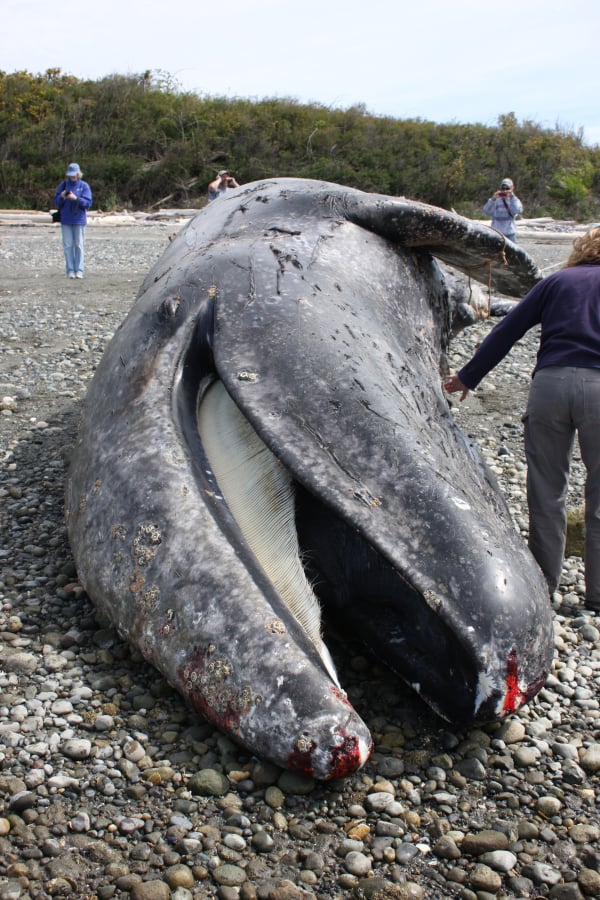PORTLAND — Gray whales are dying up and down the West Coast at an alarming rate.
Over the past five months, 23 dead whales have washed up along California’s coast. Washington has seen 11 of the massive cetaceans wash ashore. Last weekend, a whale washed up in a remote cove north of Lincoln City. Witnesses said the whale was still alive when it beached, but by the time experts arrived it was no longer breathing, the third gray whale to show up dead or dying on Oregon’s coast this year.
In 2018, the entire West Coast saw 25 gray whale strandings. Since January, at least 37 dead whales have been discovered along the West Coast. One appeared to have been attacked by orcas. Another showed health problems that could have come from an entanglement in fishing gear. Many of the whales that have washed up have been dangerously malnourished. A few have been completely emaciated.
Bruce Mate, director of Marine Mammal Institute at Oregon State University’s Hatfield Marine Science Center in Newport, Ore., said the deaths of so many underweight whales meant there wasn’t enough food in their Arctic feeding grounds.
“Nutritional stress is going to cause an adjustment to the carrying capacity,” said Mate, who has been studying gray whales for nearly 45 years. He believes that gray whales, which now exist in near-record numbers, may have reached the maximum number of animals the ecosystem can support. Warming in the Arctic and a dramatic reduction in sea ice are exacerbating the problem.
And it’s likely to get worse before it gets better, Mate said, noting that we haven’t yet reached the peak of stranding season, which usually runs from March until May.
“It won’t surprise me if we see a lot more dead animals,” Mate said.
To understand the peril facing the West Coast gray whale population, you have to understand their yearly 10,000-mile migration pattern, the longest of any whale on Earth.
In the early summer, the whales arrive in the Arctic, where they feed on small, bottom-dwelling shrimp-like creatures called amphipods. They usually stay in the north for months, bulking up for the long journey ahead of them. Once they leave the waters of the Arctic, they won’t eat again until they return. In December, the whales begin swimming south toward the coast of Mexico, where they breed and give birth.
Usually arriving in mid-February, the warm lagoons of Baja California provide protected areas for the whales to give birth. By March, the creatures start heading back up the coast, mothers with nursing calves in tow, toward the food-rich waters of the north.
The northward spring migration is when gray whales are at their most vulnerable. The animals have gone months since their last meal and new mothers expend a lot of energy tending to and nursing their young, who can consume up to 50 gallons a day of their mother’s milk.
But their precarious predicament is larger than their annual migration. In the early 20th century, gray whales were nearly hunted to extinction with between 1,000 and 2,000 of the animals remaining in the wild. In the mid-1930s, the League of Nations instituted a commercial whaling ban and other similar regulations followed suit.
In the mid-’90s, despite the fact that other gray whale populations had been driven to extinction or were dangerously low, whales along the West Coast were taken off the endangered species list because their numbers had rebounded so resoundingly.
And therein lies the problem, according to Alisa Schulman-Janiger, director of the Gray Whale Census and Behavior project in Southern California.
She said observers looked for four signs of trouble in the gray whale population: animals arriving late to their breeding grounds, a low number of calves, skinny whales and whales washing up dead in high numbers. So far this year, all the boxes have been checked.
Steven Swartz, a researcher who observes the animals at Laguna San Ignacio, a popular destination in Mexico for breeding among gray whales, saw the southern migration arrive two weeks later than usual. When the whales did show up, more than half of them were “skinny,” Swartz wrote in a summary of his observations. In previous years, 10 to 12 percent of the animals appeared underweight.
The last survey of the whales in Mexico, performed in late March, found 21 mother-calf pairs. The five-year average is three times that number.
“We biologists are hoping this winter’s increase in skinny whales and low calf counts is not the beginning of another range-wide mortality event,” Swartz wrote.
He was referring to the last time there was a mass die-off, known in the scientific community as an unusual mortality event. After they were taken off the endangered species list in 1994, the population of gray whales jumped to roughly 25,000 animals. Then, between 1999 and 2000, they started to die. Over the two-year period, the population was trimmed by a third to 17,000 whales. The cause, experts think, was that there were too many whales for the ecosystem to support.
But, again, the whales rebounded, with their numbers surging to their present population of 27,000, the largest population since the cetaceans were nearly hunted to extinction.
“Gray whales are environmental sentinels,” Schulman-Janiger said. “If gray whales look healthy, it means the Arctic ecosystem is doing well.”



